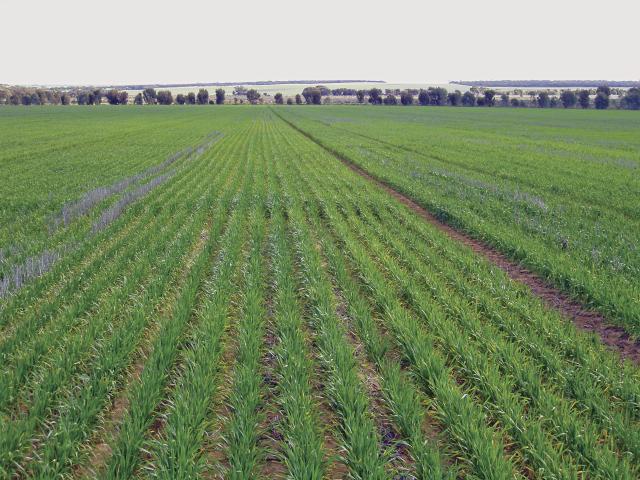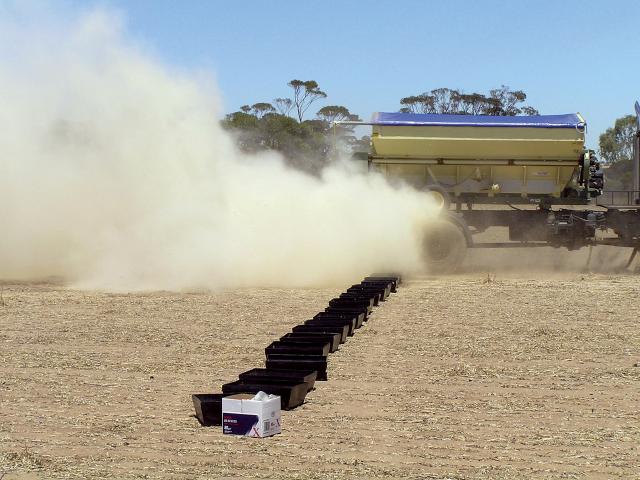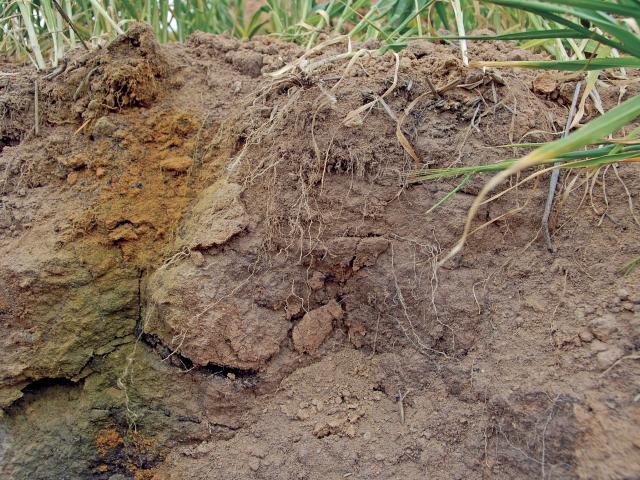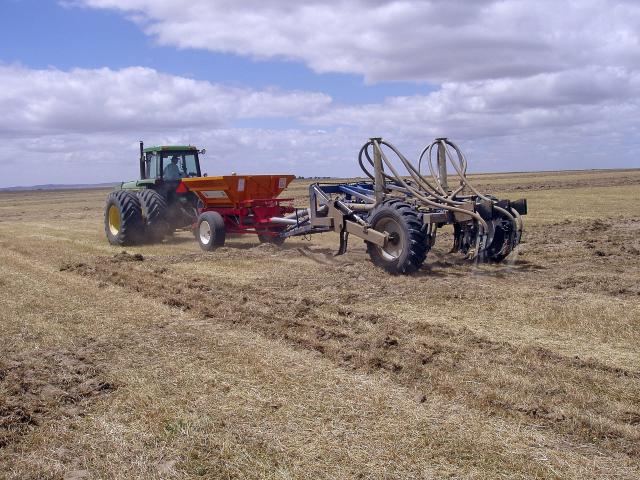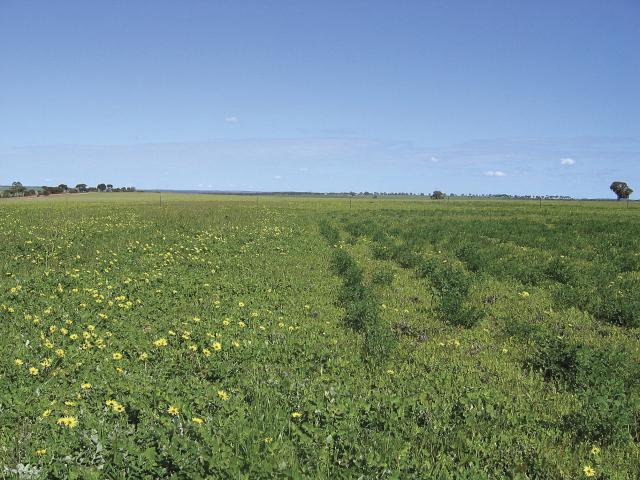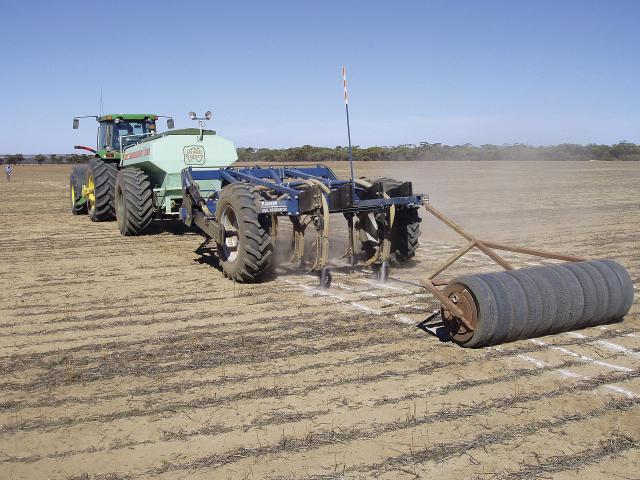Questions about liming
Why do I need to lime? What happens if I don't lime? What is the effect of soil acidity?
All forms of productive agriculture cause soil acidification. Removal of alkalinity from the farm, through exported produce and the acidifying effects of ammonium fertilisers, leaves the soil more acidic (low pH) (see Causes of soil acidity). Aluminium toxicity in acidic subsurface soil restricts root growth and access to subsoil water. Low soil pH can also reduce the chemical availability of essential plant nutrients and the activity of beneficial microorganisms (see Effects of soil acidity).
Adequate applications of agricultural lime can maintain soil pH or recover acidic soil to appropriate levels, preventing production loss due to soil acidity (see Benefits of maintaining an appropriate pH profile).
Why can't I see a response to the lime I applied?
There are several reasons why responses to liming are not observed:
- Insufficient lime (quantity and/or quality) has been applied to remove acidity as a production constraint.
- There has not been enough time for the lime applied to treat acidity in the subsurface (often takes at least 4-7 years).
- Another constraint, such as compaction, is preventing optimum production. In which case see Managing Soils to gather information about other soil constraints.
- The lime is acting to maintain an already good soil pH profile. This is the most desirable outcome because no production has been lost due to soil acidity.
Can I lime at any time of the year? Which is best, liming pasture in winter or before the crop in March? What is the value of applying lime in spring?
Liming has a long-term benefit and can be carried out at any time it fits into the farming schedule, particularly with tramline farming systems. So long as your paddock is trafficable, the earlier you apply lime, the sooner you see the benefits. Spring liming of pastures is beneficial to a following cropping rotation as there is time for the lime to start neutralising acidity, particularly if there is summer rainfall (see Applying lime).
Can I burn stubble after liming?
The temperatures reached during stubble burning will not affect lime. After burning, there is less protection against wind erosion which may result in the loss of the finer lime particles applied to the soil surface.
Why do sheep eat the stubble off lime trials first?
Where liming has removed soil acidity as a constraint to production, the crop (and subsequently the stubble), will have had better access to water and nutrients and be more palatable to sheep.
Can I spread wider with limestone?
The coarser limestone particles will spread further, but they are less reactive and effective application rates will be uneven, resulting in poor treatment of soil acidity. Spreading width should be 6-8 metres (m) (depending on wind conditions) to get good coverage of the finer particles.
Is there any effect of pH on weeds?
Like crops and pasture, weeds grow better at appropriate pH, however crops and pastures may be more competitive if the soil pH is appropriate (see the Kellerberrin and King River case studies).
Why is it recommended to apply lime over 5-10 years? Is it better to apply a larger amount of lime at once, or less more often? Is it possible to put on too much lime at once?
Surface applied lime takes a long time to treat acidity in the subsurface soil and the amount of lime required can only be estimated. If large amounts of lime are recommended, it is sensible to apply some of the lime at first and retest after 3-4 years to refine the estimate of lime requirements.
High rates of lime are unnecessary for maintenance of soil pH, but may be beneficial in recovering acidic soil. High rates of lime will neutralise soil acidity quicker and once the acidity has been neutralised, the lime dissolves only very slowly. This remaining lime will continue to treat the ongoing acidification that results from farming (see Developing a liming program).
Applying high rates of lime where some of the micro-nutrients including manganese, zinc and copper are marginal, may induce deficiencies that can be overcome by the application of appropriate solid fertiliser or foliar spray (see Effects of soil acidity).
If I have a paddock at pH 4.8 and another at 5.3, which gets priority?
This choice is complicated and it depends on the subsurface pH. You need to test the soil at 10-20 and 20-30cm as well as the topsoil. To maintain farm income, it is wise to lime to maintain the better-performing paddocks or recover the profile to appropriate pH if subsurface acidity is limiting production.
A liming program can be developed which includes liming the less productive paddocks in the future. Remember that soil acidification will continue in paddocks under agriculture and more lime will be required to recover soil pH. It is important that adequate lime be applied to treat acidity in the surface and subsurface soil (see Developing a liming program).
What rate of lime do I apply in a paddock with variable pH?
If the paddock is not uniform, management areas can be based on soil type and the pH profile. Soil sampling should be representative of these areas and lime can be applied where it is needed according to the soil pH profile. It is better to apply more lime in areas of low soil pH and less where the pH is higher, rather than a single rate over the whole paddock. For example, if some areas of a paddock required two tonnes per hectare (t/ha) and some required 3t/ha, a strategy could be to apply 2t/ha to the whole paddock, recheck pH in three years and apply 1t/ha to the areas which require a total of 3t/ha (see Developing a liming program).
Why is 2-8t/ha of lime often recommended now? This seems more than previously.
Over the last 20 years (since the old 1t/ha in 10 years recommendation) the soil profile has continued to acidify because, generally, production has increased due to improvements in agricultural practices and insufficient lime has been applied to counter the increased acidification. More lime is now required to treat and recover the more acidic soils. Liming programs need to account for existing acidity in the soil profile and ongoing acidification due to agriculture. Soil type, rainfall and farming practice need to be considered in addition to the pH of the soil profile.
At what pH should we start putting out lime? What is an acceptable low pH?
It is best to maintain pHCa at or above 5.5 in the topsoil and 4.8 in the subsurface. If the topsoil pHCa falls below 5.5, there will be insufficient alkalinity to move down and treat subsurface acidification. The best practice is to sample and test the soil every three to four years and apply lime if the pH falls below targets. At pHCa 4.8 in the subsurface root growth won't be affected by aluminium toxicity. Remember that it may take several years after liming to recover acidic subsurface soil and all the while acidification will be continuing due to farming and production will be lost.
Lime is my second largest expense per hectare after nitrogen, what strategies have I got?
You need to develop a liming program based on soil testing at 0-10, 10-20 and 20-30cm. If you can-t lime everywhere that needs it give priority to your best performing paddocks. Apply enough lime over a 5-10 year period to raise the pHCa of the topsoil to 5.5 and the subsurface soil to 4.8.
How do I get a return on liming? What is the return on investment time?
The timeframe and return on investment in liming will depend on the individual circumstance. The value of liming should be considered as value of production not lost. An increase in production in response to liming means that production has previously been lost. Maintaining soil pH at the DPIRD target levels will prevent loss due to soil acidity (see Benefits of maintaining an appropriate pH profile). If the benefits of liming are to be realised, it is important to remove other constraints to production such as subsurface compaction. For further information on compaction and other soil constraints see Managing Soils.
On leased farms with low pH, how do I prioritise whether to lime or not?
The benefits of liming are long-term and add value to the property. Liming is often required or negotiated as part of a lease agreement. On soils with low pH, particularly if the subsurface is also acidic, it may be several years after liming before production benefits are realised.
How do I get lime to move down the profile faster?
Surface-applied lime can take a long time to treat subsurface acidity. The key to minimising the time is to apply enough lime. The most important thing is to keep the surface pHCa above 5.5. If the pH falls below this alkalinity from the lime cannot move down the soil profile. Even if your surface pH is at 5.5, you need to test the subsurface at 10-20 and 20-30cm so that you know how much lime you need to treat acidity in these layers. So long as you keep the surface pHCa at 5.5 you can apply the required amount of lime in two or three applications over a few years.
Is it possible to put lime in the subsurface soil where needed if the surface is okay? Is it possible to get pH change more quickly by deep liming?
Effective deep-placement of lime is difficult to achieve and requires extensive modification of farm equipment. The adequate application of surface-applied lime will allow alkalinity to move down the profile to treat acidity in the subsurface, although it may take several years to recover an acidic soil to an appropriate pH.
If compaction is also a production constraint, applying lime to the surface prior to deep-ripping will be beneficial in incorporating some lime into the subsurface. It is probably not worth the expense of deep-ripping just to incorporate lime. Spading to incorporate surface-applied lime is a good option on some soils with subsurface acidity. For further information see Applying lime and Complementary strategies to liming.
Care needs to be taken with mouldboard ploughing to incorporate lime. A thorough job of inverting the topsoil can bury your limed topsoil under a layer of acidic subsurface soil, which could require further liming before you can successfully grow anything.
Should I get lime to depth with spading or am I better off spending the equivalent on more lime?
This will depend on your individual circumstance. If your subsurface soil is very acidic and your soil is suitable for spading, it would be worthwhile looking closely at costs and potential benefits.
If you have a layer of acidic soil constraining root growth, spading after surface application of lime can be very effective at providing pathways of higher pH soil through which roots can grow through to the non-acidic soil below. In this case acidity problems can be overcome in the first year of treatment. Some spaded and unspaded test strips with and without lime would help to determine the benefits (see the Miling case study).
At what threshold should we shift to getting lime into the subsoil with spading?
Again, this depends very much on individual circumstances and you need to carefully assess costs and benefits. If you have a severe acidity constraint, say pHCa less than 4.5 in the surface 0-10cm and subsurface 10-20 and 20-30cm layers and better pH deeper in the profile, then removing the acidity barrier by spading can provide immediate benefits.
Does lime 'leach' to depth? At what rainfall?
The movement of alkalinity depends on many interacting factors. Alkalinity will not move down the profile unless sufficient lime is applied to raise the surface pHCa to 5.5. Movement is usually quicker in higher rainfall zones.
What rates of lime should be used wih deep ripping, spading or mouldboard ploughing?
The lime will be treating a greater volume of soil in one go so this needs to be accounted for and generally higher rates should be used compared to an initial surface application. The aim is to provide pathways of higher pH soil for the roots to grow through. Once the lime is incorporated into the soil, alkalinity can move deeper, continuing to improve the soil pH profile. These techniques produce highly variable soil pH profiles so subsequent sampling will have to account for this. Spraying the surface of a small soil pit with universal pH indicator stain will give you an indication of how well the lime has been incorporated.
